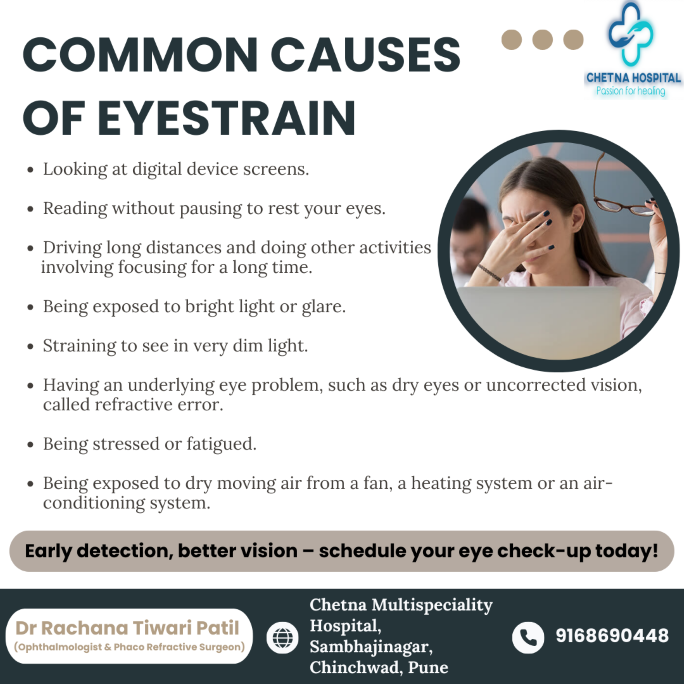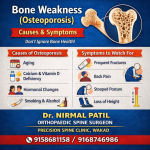In today’s digital age, eye strain has become an increasingly common problem. Whether it’s spending long hours on a computer for work, using smartphones or tablets for leisure, or even reading books, our eyes are constantly being subjected to prolonged periods of focus. Eye strain, also known as asthenopia, refers to the discomfort that results from intensive use of the eyes. While eye strain is not typically a serious medical condition, it can cause significant discomfort and interfere with daily activities. Understanding the causes, symptoms, and ways to alleviate eye strain is crucial for maintaining good eye health.
What is Eye Strain?
Eye strain occurs when your eyes get tired from intense use, especially when focusing on objects up close for extended periods. It happens when the muscles around your eyes are overworked, leading to temporary discomfort. In the modern world, this is often due to prolonged exposure to digital devices, reading, or other activities requiring focused vision.
Causes of Eye Strain
- Excessive Screen Time One of the biggest contributors to eye strain today is the widespread use of digital screens. Whether it’s working on a computer, using smartphones, or watching television, people spend hours staring at digital screens. This leads to a condition commonly known as digital eye strain or computer vision syndrome. When looking at a screen, we tend to blink less often, which leads to dry eyes, making the discomfort worse.
- Poor Lighting Lighting plays a significant role in how our eyes react to visual tasks. Working in low light or with harsh lighting can contribute to eye strain. If the screen brightness doesn’t match the ambient light, or if you’re working under dim lighting, your eyes have to work harder to focus. Overhead fluorescent lights, glare from windows, or excessive brightness from your device can cause your eyes to become fatigued more quickly.
- Improper Posture Poor posture while working, reading, or using devices is another cause of eye strain. Leaning forward or hunching over while using your computer can put additional stress on your eyes. This can cause muscle fatigue not only in the eyes but also in the neck and shoulders. Over time, improper posture can contribute to chronic discomfort and pain in the eyes and other parts of the body.
- Uncorrected Vision Problems People who have uncorrected vision problems, such as nearsightedness (myopia), farsightedness (hyperopia), or astigmatism, are at a higher risk for eye strain. If your prescription glasses or contact lenses are outdated or you have undiagnosed vision problems, your eyes must work harder to focus, which can lead to strain and discomfort.
- Dry Eyes Dry eyes can cause irritation and discomfort when you are working at a computer or looking at a screen. Dryness can occur when the eyes don’t produce enough tears to keep the surface lubricated. This can be due to factors like air conditioning, dehydration, long screen time, or even certain medications. Without enough moisture, the eyes become irritated, leading to a feeling of strain.
- Lack of Sleep Not getting enough sleep can have a negative effect on your eye health. When you’re tired, your eyes may not be able to focus properly, and this can lead to blurred vision, dryness, and discomfort. Sleep deprivation can also cause the muscles around the eyes to become fatigued, contributing to eye strain.
- Overuse of Near Vision Staring at objects up close for too long, such as reading a book, looking at a smartphone, or working on a computer, can also strain the eyes. This is because the muscles around the eyes need to work harder to focus on nearby objects. Prolonged use of near vision without taking breaks can contribute to eye strain.
Symptoms of Eye Strain
The symptoms of eye strain can vary from person to person, but some of the most common signs include:
- Eye discomfort: A feeling of tired, heavy, or sore eyes after prolonged use.
- Dryness or watering: Your eyes may feel dry or irritated, or you may experience excessive tearing as your eyes try to compensate for dryness.
- Blurred vision: Difficulty focusing on objects, especially after long periods of reading or using screens.
- Headaches: A common symptom of eye strain, particularly after using a computer or digital device for long hours.
- Neck, shoulder, or back pain: Poor posture and prolonged screen use can cause discomfort in other parts of your body, such as the neck and shoulders.
- Difficulty focusing: After long periods of reading or screen use, you may find it hard to refocus your vision, even when you look away from the screen.
How to Prevent and Relieve Eye Strain
While it may be difficult to avoid digital devices altogether, there are several steps you can take to reduce eye strain and prevent it from becoming a chronic issue.
- Follow the 20-20-20 Rule One of the most effective ways to prevent eye strain is to take regular breaks. The 20-20-20 rule states that every 20 minutes, you should look at something 20 feet away for at least 20 seconds. This gives your eyes a chance to relax and reset.
- Adjust Your Screen Ensure that your computer screen is at eye level and at a comfortable distance (about 20–30 inches from your eyes). The screen should also be positioned to avoid glare from windows or overhead lighting. Adjusting the brightness and contrast can also help make the screen easier on your eyes.
- Use Proper Lighting Make sure your work area is well-lit to prevent glare. Use a desk lamp that illuminates the work surface without creating reflections on the screen. Ideally, use soft, warm light, and avoid harsh fluorescent lighting.
- Blink Regularly When staring at screens, people tend to blink less often, which leads to dryness and discomfort. Make a conscious effort to blink more often to keep your eyes lubricated and prevent dryness.
- Wear Corrective Eyewear If you have vision problems, make sure you’re wearing the correct prescription glasses or contact lenses. Regular eye exams are essential to ensure your vision is properly corrected. Some people may also benefit from specialized computer glasses designed to reduce eye strain.
- Hydrate and Use Artificial Tears Keep your eyes hydrated by drinking plenty of water throughout the day. If you suffer from dry eyes, consider using lubricating eye drops to help keep your eyes moist.
- Practice Good Posture Pay attention to your posture while sitting and working. Sit straight, keep your shoulders relaxed, and avoid slouching. Position your screen so you don’t have to strain your neck or eyes.
- Get Enough Sleep A good night’s sleep is crucial for maintaining eye health. Aim for 7-8 hours of sleep each night to ensure your eyes are well-rested and can function properly during the day.
When to See an Eye Specialist
If you experience persistent or severe eye strain, it’s important to consult an eye specialist. Eye strain can sometimes be a sign of underlying vision problems or other health conditions. An eye exam can help identify the cause of your discomfort and ensure you receive the appropriate treatment.
Conclusion
Eye strain is a common condition that can affect anyone, especially in today’s screen-driven world. By understanding its causes and symptoms, and following simple preventive measures, you can significantly reduce the risk of eye strain and protect your eye health. Remember to take breaks, adjust your environment, maintain proper posture, and get regular eye check-ups to keep your eyes comfortable and functioning at their best.
For Consultation Contact us on 9168690448
Website – www.chetnahospital.co.in
Address – Chetna Hospital, Sambhajinagar, MIDC, G Block, Near Rotary Club, Chinchwad 411019
.
.
.
#hospital#pune#pcmc#chinchwad#medical#medicalservices#dryeyetreatment#dryeyerelief#dryeyedisease#dryeyetherapy#catract#catractsurgery#catracteyesurgery#catracteyeoperation#eyedoctor#eye#glaucoma#conjunctivitis#ophthalmologist#eyediseases#eyepain#pinkeye#hazeleyes#myopia#eyeinfection#amblyopia#dryeyesyndrome#eyeproblems#motibindu#motibinduoperation













